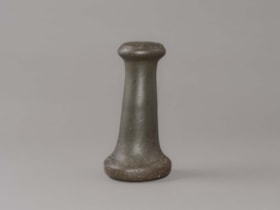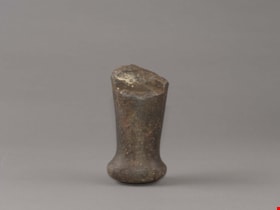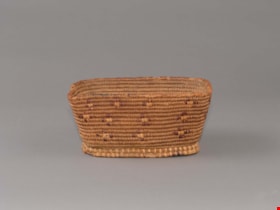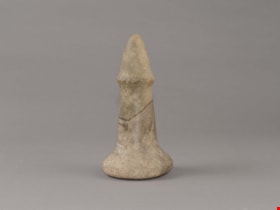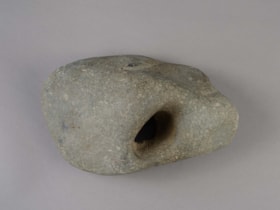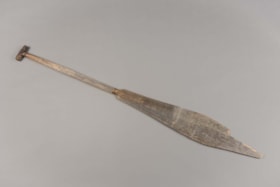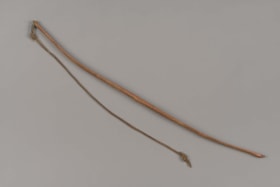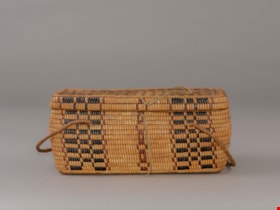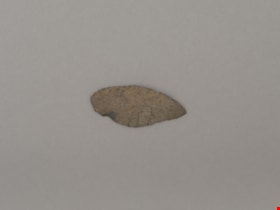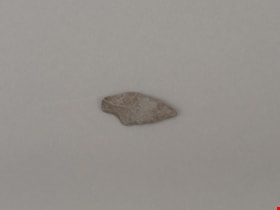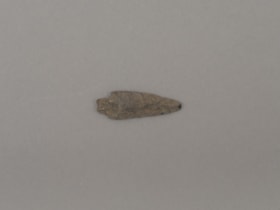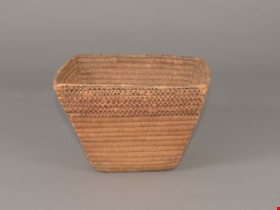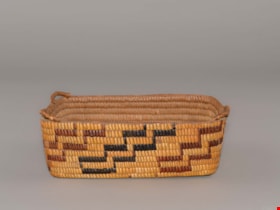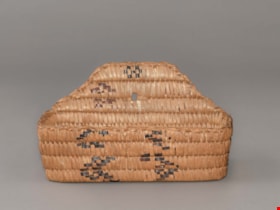Narrow Results By
Legends of Vancouver
https://search.heritageburnaby.ca/link/museumlibrary5197
- Repository
- Burnaby Village Museum
- Collection
- Special Collection
- Material Type
- Book
- Accession Code
- BV002.90.3
- Call Number
- 398.2 JOH
- Edition
- 8th ed.
- Place of Publication
- Vancouver
- Publisher
- Saturday Sunset Presses
- Publication Date
- 1913
- Physical Description
- xvii, 138 p. : ill. ; 23 cm.
- Library Subject (LOC)
- Legends--British Columbia--Vancouver Island
- Spirituality--Indigenous--North America
- Geographic Access
- Vancouver
- Notes
- Leather jacket with painted profile, title, and author, includes leather bookmark and souvenir dagger.
- Inside the jacket is a newspaper clipping of a soldier from Vancouver wounded at Vimy Ridge.
- Author's given name and dates : Johnson, E. Pauline (Emily Pauline), (Tekahionwake),1861-1913
Interview with Cice Brown, May 13, 2005 - Track 5
https://search.heritageburnaby.ca/link/museumdescription4480
- Repository
- Burnaby Village Museum
- Date
- 1930-1949 (interview content), interviewed May 10, 2005
- Collection/Fonds
- Burnaby Village Museum fonds
- Description Level
- Item
- Physical Description
- 1 sound recording (mp3) (0:07:55 min)
- Scope and Content
- Track 5: This portion of the recording continues with the topic of recreation. The next questions pertain to restrictions on children at the time, cultural diversity, living arrangements, and toys. Cice is asked to describe her best and worst memories. She mentions that there were few restrictions …
- Repository
- Burnaby Village Museum
- Collection/Fonds
- Burnaby Village Museum fonds
- Series
- Museum Oral Histories series
- Subseries
- Growing Up in Burnaby subseries
- Description Level
- Item
- Physical Description
- 1 sound recording (mp3) (0:07:55 min)
- Material Details
- Interviewer: Tom Gooden Interviewee: Cice Brown Date of Interview: May 13, 2005 Total Number of Tracks: 7 Total length of all Tracks: 0:40:19
- Scope and Content
- Track 5: This portion of the recording continues with the topic of recreation. The next questions pertain to restrictions on children at the time, cultural diversity, living arrangements, and toys. Cice is asked to describe her best and worst memories. She mentions that there were few restrictions on children, and discusses the nature of community at the time. She comments on the cultural and religious backgrounds of the people she knew. Cice describes her family’s home and living arrangements, and how they reflected her family’s situation. She recalls a favourite toy.
- History
- Recording of an interview with Cice Brown, interviewed by Tom Gooden on May 13 2005. This recording was completed for an exhibit, Growing Up in Burnaby, for the Burnaby Village Museum. Major themes discussed are growing up in Burnaby in the 1930s and 40s.
- Creator
- Burnaby Village Museum
- Names
- Brown, Cice Chandler
- Accession Code
- BV017.45.3
- Access Restriction
- No restrictions
- Reproduction Restriction
- May be restricted by third party rights
- Date
- 1930-1949 (interview content), interviewed May 10, 2005
- Media Type
- Sound Recording
Audio Tracks
Interview with Cice Brown, May 13, 2005 - Track 5, 1930-1949 (interview content), interviewed May 10, 2005
Interview with Cice Brown, May 13, 2005 - Track 5, 1930-1949 (interview content), interviewed May 10, 2005
https://search.heritageburnaby.ca/media/hpo/_Data/_BVM_Sound_Recordings/Oral_Histories/2017_0045_0003_005.mp3Four men standing on ʷməθkʷəy̓əm (Musqueam) First Nation farmland
https://search.heritageburnaby.ca/link/museumdescription4254
- Repository
- Burnaby Village Museum
- Date
- [1951] (date of original), copied 2017
- Collection/Fonds
- Burnaby Village Museum Photograph collection
- Description Level
- Item
- Physical Description
- 1 photograph (tiff) : 600 dpi
- Scope and Content
- Photograph of four men standing in farming clothing on leased farm land of the ʷməθkʷəy̓əm (Musqueam) First Nation. From L-R: Chan Kow Hong, Mr. Wong (Josephine Hong's uncle), Mr. Leong (Josephine Hong's uncle) and Gay Tim Hong. Planting crates evident on farmland in background.
- Repository
- Burnaby Village Museum
- Collection/Fonds
- Burnaby Village Museum Photograph collection
- Description Level
- Item
- Physical Description
- 1 photograph (tiff) : 600 dpi
- Scope and Content
- Photograph of four men standing in farming clothing on leased farm land of the ʷməθkʷəy̓əm (Musqueam) First Nation. From L-R: Chan Kow Hong, Mr. Wong (Josephine Hong's uncle), Mr. Leong (Josephine Hong's uncle) and Gay Tim Hong. Planting crates evident on farmland in background.
- History
- Josephine Hong was born to Sui Ha Hong and Chan Kow Hong. The Hong Family had seven children, oldest to youngest: Pauline, Josephine, Catherine, Norine, Gary, Darlene, and Marlene. The family runs Hop-On Farm on Marine Drive in Burnaby. Many Hong family members worked on the farm including Josephine Hong's grandfather, Gay Tim Hong, and uncles. Her great-grandfather was Sui Wing Hong.
- Geographic Access
- Byrne Road
- Accession Code
- BV017.36.5
- Access Restriction
- No restrictions
- Reproduction Restriction
- May be restricted by third party rights
- Date
- [1951] (date of original), copied 2017
- Media Type
- Photograph
- Historic Neighbourhood
- Fraser Arm (Historic Neighbourhood)
- Related Material
- See Oral History Interview-BV020.6.1
- Scan Resolution
- 600
- Scan Date
- 12/3/2017
- Scale
- 100
- Notes
- Title based on contents of photograph.
Images
The Indian history of British Columbia : volume 1, the impact of the white man
https://search.heritageburnaby.ca/link/museumlibrary1308
- Repository
- Burnaby Village Museum
- Author
- Duff, Wilson, 1925-1976
- Publication Date
- 1964
- Call Number
- 970.411 DUF
- Repository
- Burnaby Village Museum
- Collection
- Reference Collection
- Material Type
- Book
- Call Number
- 970.411 DUF
- Author
- Duff, Wilson, 1925-1976
- Place of Publication
- Victoria, B.C.
- Publisher
- British Columbia Dept. of Recreation and Conservation, Provincial Museum of Natural History and Anthropology
- Publication Date
- 1964
- Physical Description
- 117 p. : ill. ; 27 cm.
hand maul
https://search.heritageburnaby.ca/link/museumartifact3392
- Repository
- Burnaby Village Museum
- Accession Code
- BV988.6.1
- Description
- Flat topped stone maul.
- Subjects
- Persons
- Indigenous peoples - British Columbia
- Woodworking Tools and Equipment
- Woodworking Tools and Equipment - Maul
Images
Documents
hand maul
https://search.heritageburnaby.ca/link/museumartifact3393
- Repository
- Burnaby Village Museum
- Accession Code
- BV988.6.2
- Description
- Flat topped stone maul, broken
- Subjects
- Persons
- Indigenous peoples - British Columbia
- Woodworking Tools and Equipment
- Woodworking Tools and Equipment - Maul
Images
Documents
storage basket
https://search.heritageburnaby.ca/link/museumartifact12639
- Repository
- Burnaby Village Museum
- Accession Code
- BV985.4184.1
- Description
- Tub shaped coiled cedar root basket with cedar root foundation and overcast rim. Walls of basket flare slightly towards rim. Imbricated with designs in red cherry bark and grass. Design is known as cluster of flies. The foot on the bottom of the basket, made from two extra rows of coiling, is a feature that protects the base of the basket from wear and tear. White beading on the foot. Interior Salish: Nlaka’pamux: Spuzzum possibly
- Object History
- White beading on the foot of the basket is said to be a feature typical of Spuzzum. This was reported by basket makers from that community during collections research conducted at MOA to Sharon Fortney and Bill Mclennan.
- Country Made
- Canada
- Province Made
- British Columbia
- Culture
- Nlaka'pamux
Images
Documents
hand maul
https://search.heritageburnaby.ca/link/museumartifact15555
- Repository
- Burnaby Village Museum
- Accession Code
- HV983.32.13
- Description
- Nipple topped stone maul. Nipple topped stone maul. It has a crack through the entire shaft and the two halves look of different colour and stone type. There is a large chip missing along the crack.
- Object History
- The donor was of European decent and was given this maul by an unidentified person. In general, hand mauls are used in woodworking todrive antler wedges or spreading sticks into logs and split planks. They were also used in combination with chisels for detail work. Their presence at an archeological site is viewed as evidence of long term habitations. They are associated with house building, canoe building, housepost and welcome figure carving. Nipple top hand mauls are identified as Marpole Culture (400 BC - 400 AD).
- Country Made
- Canada
- Province Made
- British Columbia
- Culture
- First Nations
- Subjects
- Persons
- Indigenous peoples - British Columbia
- Woodworking Tools and Equipment
- Woodworking Tools and Equipment - Maul
Images
Documents
stone anchor
https://search.heritageburnaby.ca/link/museumartifact15961
- Repository
- Burnaby Village Museum
- Accession Code
- HV983.60.1
- Description
- Smooth gray stone with a irregularly shaped hole on the narrower end of the stone.
- Object History
- Anchor used to secure a house post, or post supporting a wall. Large stone with hole through center,
Images
Documents
paddle
https://search.heritageburnaby.ca/link/museumartifact16839
- Repository
- Burnaby Village Museum
- Accession Code
- HV980.2.131
- Description
- Men’s paddle carved from cedar wood. The shaft is flattened with a "T" style grip mortised at top The blade is flat with one side of the tip missing. There are other cracks in the blade.
- Object History
- Style of blade indicates it is a man’s paddle, for everyday use (see Barnett 1955:116). Anthropologist Homer Barnett notes: “Paddles were made of yellow cedar, yew, and maple. Those of maple and cedar were painted, the man’s being black and the woman’s red. A smoky pitch fire and oil gave an impenetrable black (116). Men’s paddles had a crutch or crosspiece handle – either one piece or doweled on. There were different shapes of paddles for women, steering, sealing and night hunting.
- Marks/Labels
- "Yale" written on tag.
- Country Made
- Canada
- Province Made
- British Columbia
- Site/City Made
- Yale
- School/Style
- Coast Salish
Images
Documents
hunting bow
https://search.heritageburnaby.ca/link/museumartifact16840
- Repository
- Burnaby Village Museum
- Accession Code
- HV980.2.132
- Description
- Small maple hunting bow. A leather thong is tied to one end of the bow. It is loose at the other end, although, there is a knot that could slip over the bow. There are traces of green paint on the wood. Interior Salish: Nlaka’pamux: Spuzzum First Nation
- Object History
- Homer Barnett writes about Coast Salish bows: “the main hunting bow did not differ from the one used in fighting. It was made of yellow cedar root when this wood could be obtained from the mountains. The trunk wood was also used. An alternative was yew. Inferior bows for ducks and other birds were made from hardhack. Bows were about three or four feet long/ The were rather flat and were about the breadth of three fingers at the widest parts on either side of the grip, which was constricted and slightly thicker. They tapered from the centre towards both ends. The ends were curved away from the holder for a better string purchase (1955:100)
- Plant fibres were seldom made into bow strings. More common were two-ply cords of sinew or gut. Atypically, a skin thong was used (1955:101).
- Marks/Labels
- There is writing inscribed on the inside of the bow, which reads: “1925" "Made for me by Spuzzum chief.”
- Country Made
- Canada
- Province Made
- British Columbia
- Site/City Made
- Spuzzum
- School/Style
- Coast Salish
- Culture
- Nlaka'pamux
Images
Documents
storage basket
https://search.heritageburnaby.ca/link/museumartifact17680
- Repository
- Burnaby Village Museum
- Accession Code
- HV978.2.12
- Description
- Rectangular coiled cedar root basket with cedar slat foundation. Parallel slat construction for lid, which is covered in beaded designs. Overcast handles attach to the front and back of basket at both ends. Conoid lid fits overtop of the basket, rather than lying flat. Basket body is completely imbricated with canary grass, black-dyed and red cherry bark. This amount of decoration more common on older pieces and was used to protect the surface of the basket. Leather hinges attach lid to body of basket and there are leather ties at front on lid and body of basket. Possible ladder design. Interior Salish: Nlaka’pamux
- Country Made
- Canada
- Province Made
- British Columbia
- Culture
- Nlaka'pamux
Images
Documents
basket
https://search.heritageburnaby.ca/link/museumartifact17681
- Repository
- Burnaby Village Museum
- Accession Code
- HV978.2.13
- Description
- Nut-shaped, coiled cedar root basket with cedar root foundation and watch-spring base and lid construction. Hinged lid is attached with leather ties. Covered in beading, where in the decorative elements are laid flat on surface, rather than folded into cedar root stitches as is done with imbrication. Designs are in red and black dyed cherry bark. Interior Salish: Nlaka’pamux
- Object History
- Nut-shaped baskets are identified as one of the oldest types by Haeberlin and Teit (1928: 202-3). They were used for storing berries and were also common work baskets for women, used to hold small tools – awls, thread, shells, trinkets and other odds and ends (202).
- Country Made
- Canada
- Province Made
- British Columbia
- Culture
- Nlaka'pamux
Images
Documents
projectile point
https://search.heritageburnaby.ca/link/museumartifact19193
- Repository
- Burnaby Village Museum
- Accession Code
- BV002.57.6
- Description
- Projectile point, stone; rounded end. Bifacially flaked – stone removed on both sides of the point; basalt and lead shaped
- Object History
- The donor inherited this artifact from his mother, Katherine Maude (Kitty) Peers, who inherited them from her father, Louis Claude Hill. The artifacts were found on his farm, Brookfield Farm, at Douglas Road and Sperling Avenue (now site of Burnaby Village Museum).
- Culture Phase: Possibly Locarno Beach phase (3520 -2200 Before Present)
- Historic Neighbourhood
- Burnaby Lake (Historic Neighbourhood)
Images
Documents
projectile point
https://search.heritageburnaby.ca/link/museumartifact19194
- Repository
- Burnaby Village Museum
- Accession Code
- BV002.57.7
- Description
- Projectile point, stone; indented on one side. Triangular stemmed projectile point
- Object History
- The donor inherited this artifact from his mother, Katherine Maude (Kitty) Peers, who inherited them from her father, Louis Claude Hill. The artifacts were found on his farm, Brookfield Farm, at Douglas Road and Sperling Avenue (now site of Burnaby Village Museum).
- Culture Phase: Possibly Locarno Beach phase (3520 -2200 Before Present)
- Geographic Access
- Deer Lake Avenue
- Historic Neighbourhood
- Burnaby Lake (Historic Neighbourhood)
- Planning Study Area
- Burnaby Lake Area
Images
Documents
projectile point
https://search.heritageburnaby.ca/link/museumartifact19195
- Repository
- Burnaby Village Museum
- Accession Code
- BV002.57.8
- Description
- Projectile point, stone. Lancelot, parallel stemmed – stem has straight sides (squared off appearance).
- Object History
- The donor inherited this artifact from his mother, Katherine Maude (Kitty) Peers, who inherited them from her father, Louis Claude Hill. The artifacts were found on his farm, Brookfield Farm, at Douglas Road and Sperling Avenue (now site of Burnaby Village Museum).
- Longer points like this were used on spears; sometimes in combination with a tool called an atl atl (spear thrower).
- Culture Phase: Possibly Locarno Beach phase (3520 -2200 Before Present)
- Historic Neighbourhood
- Burnaby Lake (Historic Neighbourhood)
Images
Documents
berry basket
https://search.heritageburnaby.ca/link/museumartifact27527
- Repository
- Burnaby Village Museum
- Accession Code
- HV974.119.1
- Description
- Trapezoidal shaped, coiled cedar root basket with cedar slat foundation. Finished with an overcast rim with root foundation. Design elements missing from one side of the basket, which is uncommon but has been seen on cradles from the Mount Currie area (Interior Salish: Lil'wat). It was perhaps the side that rests on the wearer's back. Steeply angled sides.
- Coast Salish: Sḵwx̱wú7mesh? Interior Salish: Stl’atl’imx: Lil’wat?
- Object History
- The donor reported that the baskets were traded in the early 1920s for clothes by the donor's mother, who lived in North Vancouver. Her mother told her the "Capilano Indians" used to go door to door with their baskets in North Vancouver.
- Design elements missing from one side of the basket – possibly the side that would have rested against the owner’s back.
- Steeply angled sides keep berries from crushing those at bottom of basket. Work baskets have sides that are more rounded.
- Baskets like these were used with a woven tumpline (wool strap) that was worn against the forehead, while basket was carried on back.
- Country Made
- Canada
- Province Made
- British Columbia
- Culture
- Stl’atl’imx
Images
Documents
work basket
https://search.heritageburnaby.ca/link/museumartifact27528
- Repository
- Burnaby Village Museum
- Accession Code
- HV974.119.2
- Description
- Rectangular coiled cedar root basket with cedar slat foundation and remnants of a loopwork rim. The shiny appearance of this grass suggests it is canary grass. Black dyed and red cherry bark are used for the zigzag designs. Coast Salish: Sḵwx̱wú7mesh?
- Object History
- The donor reported that the baskets were traded in the early 1920s for clothes by the donor's mother, who lived in North Vancouver. Her mother told her the "Capilano Indians" used to go door to door with their baskets in North Vancouver.
- Zig zags are sometimes referred to as lightening or snake tracks.
- Country Made
- Canada
- Province Made
- British Columbia
- Culture
- Sḵwx̱wú7mesh
Images
Documents
basket
https://search.heritageburnaby.ca/link/museumartifact27529
- Repository
- Burnaby Village Museum
- Accession Code
- HV974.119.3
- Description
- Rectangular coiled cedar root basket with cedar slat foundation, lid has parallel slat construction and is covered with beaded designs edged by imbrication in canary grass. Basket has a flat lid that is hinged to body with leather ties. A mistake was made in how the design was applied to one end of this basket. This is not common as many weavers would correct this mistake. Completely imbricated walls, beaded design on lid. Coast Salish: Sḵwx̱wú7mesh?
- Object History
- The donor reported that the baskets were traded in the early 1920s for clothes by the donor's mother, who lived in North Vancouver. Her mother told her the "Capilano Indians" used to go door to door with their baskets in North Vancouver.
- Diamonds are considered a star pattern and are common to Sḵwx̱wú7mesh and Nlaka’pamux basketry. The main design resembles a ladder or fence and is uncommon.
- Country Made
- Canada
- Province Made
- British Columbia
- Culture
- Sḵwx̱wú7mesh
Images
Documents
comb basket
https://search.heritageburnaby.ca/link/museumartifact29797
- Repository
- Burnaby Village Museum
- Accession Code
- HV973.69.4
- Description
- Rectangular shaped coiled cedar root basket with cedar slat foundations and triangular shaped posterior wall that is higher than the other three. There is a small opening at the top of this wall to allow the basket to be hung.
- Designs are done in black dyed cherry bark. Beaded designs are made by laying decorative materials flat over the surface of the coils, and securing them in place with alternating stitches of the cedar root.
- Coast Salish: Tsleil-Waututh?
- Object History
- A comb basket that was created for sale or trade. The chevron shaped designs are associated with flying geese, and are also used for knitting and weavings. The designs at the top of the basket, above the opening, are called cluster of flies. These designs are common amongst the Coast Salish. There are spaces where the foundation materials show, rows are not even width, the beaded designs are irregular. These are often traits associated with learning.
- Measurements
- Wth. 3 1/2 inches X Lth. 8 1/4 inches
- Country Made
- Canada
- Province Made
- British Columbia
- School/Style
- Coast Salish
- Culture
- Tsleil-Waututh
![Four men standing on ʷməθkʷəy̓əm (Musqueam) First Nation farmland, [1951] (date of original), copied 2017 thumbnail](/media/hpo/_Data/_BVM_Images/2017/2017_0036_0005_001.jpg?width=280)
